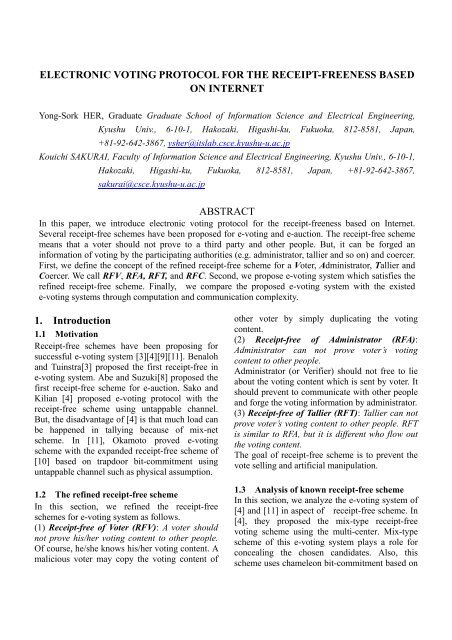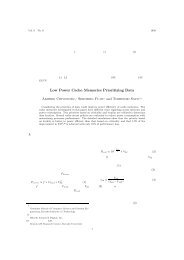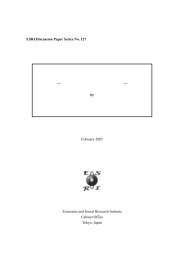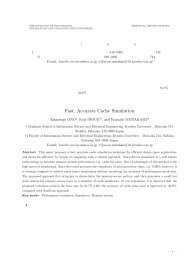1. Introduction ELECTRONIC VOTING ... - System LSI Lab.
1. Introduction ELECTRONIC VOTING ... - System LSI Lab.
1. Introduction ELECTRONIC VOTING ... - System LSI Lab.
You also want an ePaper? Increase the reach of your titles
YUMPU automatically turns print PDFs into web optimized ePapers that Google loves.
<strong>ELECTRONIC</strong> <strong>VOTING</strong> PROTOCOL FOR THE RECEIPT-FREENESS BASED<br />
ON INTERNET<br />
Yong-Sork HER, Graduate Graduate School of Information Science and Electrical Engineering,<br />
Kyushu Univ., 6-10-1, Hakozaki, Higashi-ku, Fukuoka, 812-8581, Japan,<br />
+81-92-642-3867, ysher@itslab.csce.kyushu-u.ac.jp<br />
Kouichi SAKURAI, Faculty of Information Science and Electrical Engineering, Kyushu Univ., 6-10-1,<br />
Hakozaki, Higashi-ku, Fukuoka, 812-8581, Japan, +81-92-642-3867,<br />
sakurai@csce.kyushu-u.ac.jp<br />
ABSTRACT<br />
In this paper, we introduce electronic voting protocol for the receipt-freeness based on Internet.<br />
Several receipt-free schemes have been proposed for e-voting and e-auction. The receipt-free scheme<br />
means that a voter should not prove to a third party and other people. But, it can be forged an<br />
information of voting by the participating authorities (e.g. administrator, tallier and so on) and coercer.<br />
First, we define the concept of the refined receipt-free scheme for a Voter, Administrator, Tallier and<br />
Coercer. We call RFV, RFA, RFT, and RFC. Second, we propose e-voting system which satisfies the<br />
refined receipt-free scheme. Finally,we compare the proposed e-voting system with the existed<br />
e-voting systems through computation and communication complexity.<br />
<strong>1.</strong> <strong>Introduction</strong><br />
<strong>1.</strong>1 Motivation<br />
Receipt-free schemes have been proposing for<br />
successful e-voting system [3][4][9][11]. Benaloh<br />
and Tuinstra[3] proposed the first receipt-free in<br />
e-voting system. Abe and Suzuki[8] proposed the<br />
first receipt-free scheme for e-auction. Sako and<br />
Kilian [4] proposed e-voting protocol with the<br />
receipt-free scheme using untappable channel.<br />
But, the disadvantage of [4] is that much load can<br />
be happened in tallying because of mix-net<br />
scheme. In [11], Okamoto proved e-voting<br />
scheme with the expanded receipt-free scheme of<br />
[10] based on trapdoor bit-commitment using<br />
untappable channel such as physical assumption.<br />
<strong>1.</strong>2 The refined receipt-free scheme<br />
In this section, we refined the receipt-free<br />
schemes for e-voting system as follows.<br />
(1) Receipt-free of Voter (RFV): A voter should<br />
not prove his/her voting content to other people.<br />
Of course, he/she knows his/her voting content. A<br />
malicious voter may copy the voting content of<br />
other voter by simply duplicating the voting<br />
content.<br />
(2) Receipt-free of Administrator (RFA):<br />
Administrator can not prove voter’s voting<br />
content to other people.<br />
Administrator (or Verifier) should not free to lie<br />
about the voting content which is sent by voter. It<br />
should prevent to communicate with other people<br />
and forge the voting information by administrator.<br />
(3) Receipt-free of Tallier (RFT): Tallier can not<br />
prove voter’s voting content to other people. RFT<br />
is similar to RFA, but it is different who flow out<br />
the voting content.<br />
The goal of receipt-free scheme is to prevent the<br />
vote selling and artificial manipulation.<br />
<strong>1.</strong>3 Analysis of known receipt-free scheme<br />
In this section, we analyze the e-voting system of<br />
[4] and [11] in aspect ofreceipt-free scheme. In<br />
[4], they proposed the mix-type receipt-free<br />
voting scheme using the multi-center. Mix-type<br />
scheme of this e-voting system plays a role for<br />
concealing the chosen candidates. Also, this<br />
scheme uses chameleon bit-commitment based on
discrete-log. For each voter, the last counting<br />
center posts encrypted 1-votes and 0-votes in<br />
random order and commits to the ordering using<br />
chameleon bit commitments. But, the voter can<br />
open these commitments arbitrarily. Moreover,<br />
the voter knows how each center shuffled the<br />
encrypted voting content, and knows the leakage<br />
of his/her voting. So, it does not satisfy with<br />
RFV.<br />
In [11], he assumes an untappable channel and<br />
the parameter registration committee (PRC). A<br />
physical apparatus which is called an “untappable<br />
channel” for voterV i can send out a message m ,<br />
to recipient R , and all others can know<br />
(information theoretically) nothing about m . Let<br />
R 1, R2,<br />
L,<br />
R N be PRC members Public<br />
parameters are the same with the original scheme.<br />
V i randomly generates α i ∈ Z q and splits<br />
αi<br />
into N pieces, αi , 1, L,<br />
αi,<br />
N such<br />
that α = αi, 1, L,<br />
αi,<br />
N mod q . Vi<br />
then calculates<br />
α<br />
G g<br />
i<br />
i,<br />
j<br />
i = mod p ,and Gi,<br />
j = g mod p( j = 1, L,<br />
N)<br />
.<br />
In voting stage, a voter sends ( v i , ri<br />
, mi<br />
) to timeless<br />
commission member T through an untappable<br />
anonymous channel. T publishes the list of<br />
votes in random order on the board, and also<br />
shows a non-interactive modification of<br />
zero-knowledge proof σ , to prove that the list of<br />
V i contains only correct open values of the list of<br />
m i without revealing the linkage between<br />
mi<br />
and V i . The important core of their<br />
receipt-scheme is σ that everyone with the<br />
exception of T does not know how to<br />
calculate σ . But, a voter V knows α ,<br />
α<br />
α = α L,<br />
mod q , G = g<br />
i<br />
mod p ,<br />
i, 1 , αi,<br />
N<br />
αi,<br />
j<br />
Gi,<br />
j = g mod p , m i , xi<br />
and A’s blind signature<br />
s i . The advantage of this scheme is that most of<br />
information on voting contents are concentrated<br />
to the voter. For example,<br />
( mi<br />
|| Gi<br />
|| Gi, 1 || L || Gi,<br />
N , si<br />
) is published by voter on<br />
the bulletin board. Everyone can see data on the<br />
bulletin board. A voter can prove his/her vote to a<br />
malicious people. Because a voter<br />
know m || G || G || L || G , s ) from bulletin<br />
α<br />
( i i i, 1 i,<br />
N i<br />
i<br />
i<br />
i<br />
board and can open ( mi<br />
|| Gi<br />
|| Gi, 1 || L || Gi,<br />
N , si<br />
) . It<br />
should be the distributed voting content for<br />
receipt-free scheme.<br />
<strong>1.</strong>4 Our contribution<br />
Recently, the receipt-free scheme is to be issued<br />
in e-voting and e-auction. For successful<br />
receipt-freeness, we should consider an outsider<br />
(or coercer) as well as all the participating<br />
authorities. In this paper, we refined the<br />
receipt-free scheme. As a basis of the refined<br />
receipt-free scheme, we analyzed receipt-free<br />
schemes of [4] and [11] (refer to Table 2). Both<br />
receipt-free schemes do not satisfy all the refined<br />
receipt-free schemes. In this paper, we proposed<br />
e-voting system which can satisfy the refined<br />
receipt-free scheme based on chameleon<br />
bit-commitment and secret sharing scheme. In the<br />
existed receipt-free schemes based on<br />
bit-commitment scheme, a voter generates secret<br />
seeds of bit-commitment. Therefore, a voter can<br />
open these commitments at any time. This can be<br />
caused that a voter can prove his/her voting to<br />
other people. To prevent this problem,<br />
administrator generates the secret seeds in the<br />
proposed e-voting system as Table <strong>1.</strong><br />
Table 1 Comparison with the generator of<br />
secret seeds<br />
Who generates the secret<br />
seeds?<br />
Our system<br />
Administrator<br />
[11] Voter<br />
[4] Voter<br />
Moreover, in application system based on<br />
cryptography techniques, efficiency and security<br />
are very important schemes. In this paper, we<br />
compared efficiency in aspect of computation and<br />
communication complexity. When a voter casts<br />
the voting, the scheme of [11] needs the<br />
communication complexity of 5O(m)+O(b) . This<br />
result is same with our scheme. In case of [4], it<br />
needs the communication complexity of<br />
3O(m)+2O(b). In conclusion, the scheme of [4]
needs more challenger-response than [11] and our<br />
scheme. Satisfying all the refined receipt-free, our<br />
scheme has the same communication complexity<br />
with the scheme of [11]. In Section 4, we will<br />
give a more detailed explanation about<br />
computation and communication complexity.<br />
Table 2 Comparison of the refined receipt-free<br />
scheme<br />
RFV RFA RFT<br />
Our<br />
<strong>System</strong><br />
Yes Yes Yes<br />
[4] No No Yes<br />
[11] No No Yes<br />
2. Related works<br />
2.1 RSA encryption<br />
RSA cryptosystem, named after its inventors<br />
R.Rivest, A.Shamir, and L.Adleman, is the most<br />
widely used public-key cryptosystem.<br />
- Generate two large random p and q (each<br />
roughly the same size)<br />
- Compute n = pq and Φ( n ) = ( p −1)(<br />
q −1)<br />
- Select a random integer e , 1 < e < Φ , such that<br />
gcd( e , Φ )=1<br />
- Use the refined Euclidean algorithm to compute<br />
the unique integer d , 1 < d < Φ , such that<br />
ed ≡ 1(mod<br />
Φ)<br />
.<br />
- Public key is ( n, e ) and private key is d .<br />
2.2 Bit-commitment using variable secret<br />
sharing<br />
For RFT and RFC, we use bit-commitment using<br />
Variable Secret Sharing (called VSS). VSS was<br />
proposed by A.Shamir [1]. A dealer divides some<br />
secret information into n , and divides the divided<br />
information among n -participants. By means of<br />
need, it is restored to the original state by means<br />
of need. We apply this VSS to bit-commitment as<br />
follows.<br />
- A dealer chooses his secret key x j ∈ Z q of<br />
bit-commitment and publishes his public key<br />
x j<br />
h j = g<br />
- A dealer chooses his secret seeds ri<br />
, j ∈ Zq<br />
randomly and computes a sequence of<br />
bit-commitment<br />
m r<br />
C k j<br />
k j g h<br />
,<br />
, = j<br />
, where m is the important message.<br />
- A dealer divides C k , j to k , and distributes the<br />
dividedC , between each participant.<br />
k<br />
j<br />
C k , j = C1,<br />
j + C 2, j + L + C k , j<br />
m1,<br />
j<br />
= g h<br />
r1,<br />
j<br />
j<br />
+ g<br />
m2,<br />
j<br />
h<br />
r2,<br />
j<br />
j<br />
+ L + g<br />
mk<br />
, j<br />
h<br />
rk<br />
1, j<br />
j<br />
- To recover, it needs the divided C k , j of each<br />
participant.<br />
3. E-voting system for the refined<br />
receipt-free scheme<br />
3.1 Players<br />
Voter V i . A voter follows the election law of<br />
each country.<br />
Administrator A . Administrator has a list of<br />
legitimated voters and plays the role of the<br />
determination whether the ballot is valid or not,<br />
and verifies double-voting. Also, administrator<br />
generates bit-commitment for the receipt-free.<br />
Multi-tallier T j { T j | j = 0,1,2, L,<br />
k}<br />
. Our e-voting<br />
system needs k + 1 talliers from T0<br />
to T k .<br />
Tallier T 0 plays the role for counting of voting<br />
results.<br />
Bulltin-Board BB . In bulletin board, everyone<br />
can see whether a voter casts to voting or not. But,<br />
they can not erase and modify voting contents.<br />
Bulletin board plays a important roles to prevent<br />
the voting forgery.<br />
Preparation<br />
The proposal E-voting system consists of Voter,<br />
Administrator, Multi-tallier, and Bulletin-Board.<br />
Let A be administrator and { T j | j = 0,1,2, L,<br />
k}<br />
be<br />
Talliers and C = { l | l = 0,1,2, L,<br />
k}<br />
be candidates.<br />
Voter can choose the i -th candidate. Let be large<br />
primes p = 2 q +1, q<br />
and a generator g of order<br />
q subgroup of<br />
Z * p .<br />
3.2 Procedure
Notation<br />
v : Voting content of a voter<br />
- i<br />
- d e , N A<br />
( N A = p Aq<br />
A )<br />
- p A, q A , p T q T<br />
- i<br />
1<br />
: Public key of administrator<br />
: Large prime numbers<br />
S : Signature of administrator<br />
- x : Random number<br />
- N T : Public key of administrator ( N T = pT<br />
qT<br />
)<br />
- N T , y : Public key of tallier T 0<br />
- r i , j : Secret seeds of bit-commitment ( ri, j ∈ Z q )<br />
- x j : Secret key of bit-commitment by<br />
administrator ( x j ∈ Z q )<br />
: Public key of bit-commitment by<br />
- h j<br />
j<br />
administrator ( h = g )<br />
j<br />
x<br />
(1) Stage I : Authentication of a voter<br />
- Voter Vi<br />
makes his/her ID i , and encrypts<br />
IDi<br />
with administrator’s public key < d e , N<br />
1 A > as<br />
follows, and sends it to administrator.<br />
Bi<br />
=<br />
d<br />
IDi<br />
)<br />
e<br />
(<br />
1<br />
mod N A<br />
- Administrator decrypts B i with his/her secret<br />
key, and checks the right to voting and signs B i as<br />
follows.<br />
S i = σ i ( B i )<br />
- Administrator sends S i to voter, and sends<br />
S || ID ) to Bulletin-Board.<br />
( i i<br />
- Administrator chooses his secret<br />
seeds rl<br />
, j ∈ Zq<br />
( j = 1,2, L,<br />
k)<br />
randomly and computes<br />
a sequence of chameleon bit-commitments. l is<br />
the number of voters.<br />
Z<br />
i r<br />
C g h l , j<br />
, =<br />
l<br />
j<br />
- Administrator publishes the sequence of<br />
commitments ( Cl, 1,<br />
Cl,2<br />
, L , Cl,<br />
k ) .<br />
- Administrator sends each commitment<br />
C , C , L,<br />
C ) to each tallier T )<br />
( l, 1 l,2<br />
l,<br />
k<br />
j<br />
( T 1 − k .<br />
(3) Stage III : Counting stage<br />
- Administrator proves to each tallier T j that<br />
administrator knows the secret key log g h j = x j of<br />
the chameleon bit-commitment and the discrete<br />
logs log g C l , j by the interactive zero-knowledge<br />
proof.<br />
- Administrator sends secret seeds j<br />
(2) Stage II : Voting stage<br />
- Voter chooses a vote v i and encrypts v i using the<br />
public key < N T , y > of tallierT 0 .<br />
v r<br />
Zi<br />
= y<br />
i<br />
T x<br />
t<br />
mod NT<br />
( i || Zi<br />
- Voter encrypts S ) using the public key of<br />
administrator.<br />
E A( Si<br />
|| Zi<br />
)<br />
E A( Si<br />
|| Zi<br />
- Voter sends ) to administrator.<br />
- Administrator decrypts E A( Si<br />
|| Zi<br />
) and<br />
checks S i and Z i .<br />
- Administrator chooses his secret key x j ∈ Zq<br />
of<br />
chameleon bit-commitment and his public<br />
x j<br />
key g<br />
h j = .
counting. In order to be opened the voting content,<br />
it needs tallierT o ’s secret key, and it has to receive<br />
the secret seed r l , j for decryption. But, he can not<br />
know these data.<br />
Theorem 2 (RFA) Administrator can not prove<br />
voter’s voting content to other people.<br />
After a voter cast the voting, a voter encrypts the<br />
voting vi<br />
with the public key of tallier T o , and<br />
sends the encrypted voting Z i content to<br />
administrator with signature of administrator.<br />
Administrator can check whether a voter is a legal<br />
voter or not with his signature and voter’s ID of<br />
bulletin board. But, he can not decrypt the<br />
encrypted Z i , because he does not know<br />
tallierT o ’s secret key.<br />
Theorem 3 (RFT) Tallier can not prove voter’s<br />
voting content to other people.<br />
Our e-voting system consists of k + 1 tallier.<br />
TallierT o plays a role as the counting of voting<br />
results, and talliers ( T 1 − T k ) play roles to manage<br />
secret seeds rl<br />
, j<br />
of chameleon bit-commitment.<br />
Because administrator re-encrypts the encrypted<br />
voting content Z<br />
i<br />
, and sends C l , j ( j = 1, Lk)<br />
to<br />
talliers ( T 1 − T k ) . Talliers ( T 1 − T k ) do not know the<br />
voting content.<br />
Table 3 and Table 4 show communication<br />
complexities of the existed e-voting systems and<br />
our e-voting scheme. The number of voter,<br />
multi-tallier(or multi-center), and candidate is a, b,<br />
m respectively. ↔ means both-direction<br />
communication, → means one-way direction.<br />
Also, BB is bulletin board, and B j A i means<br />
the one-way untappable channel from B j to A i .<br />
Table 5 shows computational complexities of the<br />
existed e-voting system and our e-voting scheme.<br />
Table 3 The communication complexity of<br />
the existed e-voting systems and our e-voting<br />
scheme<br />
Pattern Roun Vol<br />
[11]<br />
[4]<br />
Our<br />
Scheme<br />
Voting<br />
Voting<br />
Voting<br />
Voting<br />
Claiming<br />
Counting<br />
Voting<br />
Voting<br />
Voting<br />
Voting<br />
Authentica<br />
tion<br />
Authentica<br />
tion<br />
Voting<br />
(Commit)<br />
Voting<br />
(Proof)<br />
Voting<br />
(Secret<br />
Share)<br />
Counting<br />
d ume<br />
V i → BB a O(m)<br />
V i → T a O(m)<br />
Vi<br />
⇒ R j b × a O(m)<br />
R j → BB a O(m)<br />
R j → BB a × m O(m)<br />
T ↔ BB b O(b)<br />
C j → BB b O(m)<br />
C j → BB 2b 2O(b)<br />
C j → Vi<br />
b × a O(m)<br />
j Vi<br />
C ⇒ a O(m)<br />
v i ↔ A 2a O(m)<br />
v i → A a O(m)<br />
B j → BB b O(m)<br />
A i ↔ BB 3b O(m)<br />
B j → A i b × a O(m)<br />
A i ↔ BB a × m O(m)<br />
Table 4 The comparison of communication<br />
complexity<br />
Scheme<br />
Volume of communication<br />
complexity<br />
[11] 5O(m)+O(b)<br />
[4] 3O(m)+2O(b)<br />
Our scheme<br />
5O(m)+O(b)<br />
Table 5 The computation complexity of the<br />
existed e-voting systems and our e-voting<br />
scheme<br />
Communication<br />
Complexity
[11] Voter<br />
[4]<br />
Our<br />
Scheme<br />
Voter<br />
Centers<br />
Voter<br />
Administrator<br />
m chameleon BCs,<br />
1+m proofs and m<br />
secret sharings<br />
m chameleon BCs,<br />
1+m proofs and m<br />
secret sharings<br />
M interpolations and<br />
verifications of the<br />
commitment<br />
m chameleon BCs,<br />
1+m proofs and m<br />
secret sharings<br />
m interpolations and<br />
verifications of the<br />
commitments<br />
5. Conclusion<br />
Recently, several receipt-free schemes have been<br />
proposed for secure e-voting and e-auction. But,<br />
these schemes did not consider to all the<br />
participating authorities. In this paper, we defined<br />
the refined receipt-free scheme for e-voting.<br />
Moreover, we proposed e-voting protocol which<br />
satisfies the refined receipt-free scheme.<br />
We compared the proposed e-voting system with<br />
[4] and [11] in aspect of computation and<br />
communication complexity. The communication<br />
complexity of the proposed e-voting is similar to<br />
those of [4] and [11]. But, the proposed e-voting<br />
system satisfies the refined receipt-free scheme,<br />
RFV, RFA, RFT, and RFC.<br />
ACKNOWLEDGEMENT<br />
The first author has been supported by the<br />
Grant-in-Aid for CreativeScientific Research<br />
No.14GS0218 (Research on <strong>System</strong> <strong>LSI</strong> Design<br />
Methodology for Social Infrastructure, Head of<br />
Researchers : Prof. Hiroto Yasuura, <strong>System</strong> <strong>LSI</strong><br />
Research center, Kyushu University) of the<br />
Ministry of Education,Science, Sports and<br />
Culture(MEXT) from 2002 to 2006.<br />
Crėpeau,”Minimum Disclosure Proofs of<br />
Know ledge”, Journal of Computer and<br />
<strong>System</strong> Sciences, Vol.37, No.2, pp156-189,<br />
1988.<br />
[3] J. Benaloh and D.Tuinstra, “ Receipt-Free<br />
Secret-Ballot Elections”, Proc. of STOC’94,<br />
pp544-553, 1994.<br />
[4] K.Sako and J. Kilian, “Receipt-Free<br />
Mix-type Voting Scheme”, Proc, of<br />
Eurocrytpt’95, LNCS 921, Springer-Verlag,<br />
pp393-403, 1995.<br />
[5] K.Sako and J. Kilian, “Secure Voting Using<br />
Partially Compatible Homomorphisms”,<br />
Proc. of Crypto’94, LNCS 839,<br />
Springer-Verlag, pp411-424, 1994.<br />
[6] J. Benaloh and M. Yung, “Distributing the<br />
Power of a Government to Enhance the<br />
Privacy of Votes”, Proc. of PODC’86,<br />
pp.52-62, 1986.<br />
[7] K.J.KIM, J.H. KIM, B.C. LEE, and G.W. A,<br />
“Experimental Design of Worldwide<br />
Internet Voting <strong>System</strong> using PKI”<br />
SSGRR2001, L’Aquila, italy, Aug, 200<strong>1.</strong><br />
[8] M.Abe and K. Suzuki, “Receipt-Free<br />
Sealed-Bid Auction”, ISC2002, LNCS 2433,<br />
pp191-199, 2002<br />
[9] M.Hirt and K.Sako, “Efficient receipt-free<br />
voting based on homomorphic encryption”,<br />
Eurocrypt 2000, LNCS 1807, pp539-556,<br />
2000.<br />
[10] T. Okamoto, “An Electronic Voting<br />
Scheme”, Proc. of IFIP’96, Advanced IT<br />
Tools, Chapman & Hall, pp 21-30, 1996.<br />
[11] T. Okamoto, “Receipt-Free Electronic<br />
Voting Schemes for Large Scale Elections”,<br />
Security Protocols Workshop, 1997.<br />
REFERENCES<br />
[1] A. Shamir, “ How to share a secret”<br />
Communications of the ACM, pp612-613,<br />
1979.<br />
[2] G.Brassard, D. Chaum and C.















